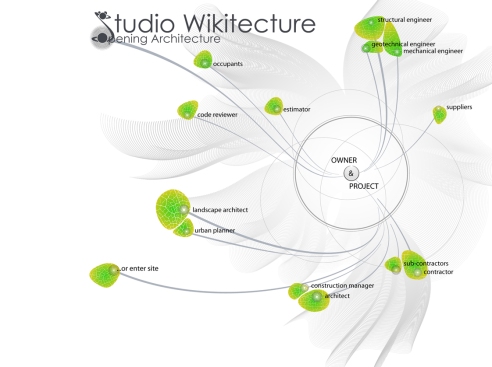You are currently browsing the category archive for the ‘collaborative design’ category.
Thanks to everyone who submitted designs during the first round of development on Treet TV’s master plan! As usual, the Studio Wikitecture team came up with some amazing and creative ideas, and it gave Treet TV a lot to think about! As with many planning projects, the goals and objectives were not very clear in the beginning – but the Wikitecture process was very effective in helping flesh out a wide variety of different ideas.
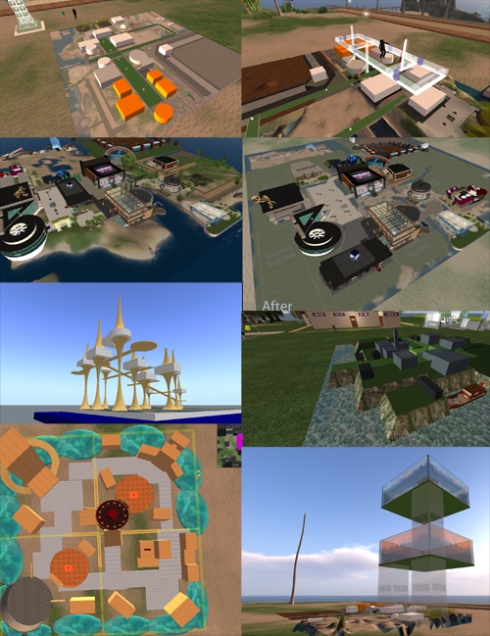
Go to the following site for more information on each design: http://www.studiowikitecture.com/Treet/all_designs.php5 (you’ll need to be logged in first)
With these proposals, we were able to gather some invaluable feedback and reactions from Treet TV’s management team, and have included that feedback below.
We will keep design development open until November 17th, at which time we will invite everyone to cast their votes to determine the most popular designs. We will also meet with Treet TV’s management team again, and based on their feedback and the voting results, we will choose 2 designs that are most promising.
We will then work on refining and combining those top designs for 2 more weeks, ending December 1st.
With a final voting round, we will then have arrived at a final design proposal, and will spend 1 final week polishing that design – finishing the project on December 8th.
We will then hold a final, public presentation of the concept to Treet TV sometime during the 2nd week of December.
If anyone has any questions, please don’t hesitate to ask! We can be reached at info @ studiowikitecture.com
If you haven’t had a chance to submit any ideas yet – now is the time! With fresh feedback, and a more clear sense of Treet’s objectives, this is an ideal time to jump in and offer up some ideas! Anyone is welcome to join and contribute!
Here is the feedback from Treet TV:
When looking at a design, here are some of the questions that are good to ask. None of these are requirements, but all are the kinds of things that we will look for.
- Where are the common areas? And where are the areas that are available to be occupied by new tenants and for new uses?
- The areas “available” need to be attractive and inviting so people understand that they are ready to be occupied. What design elements encourage people to be attracted to areas available to build?
- Where will visitors land for orientation?
- Each island has a telehub. Will each island have a visitor orientation space? Or, will each island telehub be a “mini orientation space” that leads them somewhere else?
- Where are areas suitable for the “special purposes” listed below?
- Are there areas of “sacred ground” that people know are never going to be developed, but are public and open so people can gather and enjoy themselves?
- If somebody wants temporary studio space, where is the most likely place?
- If a visitor tour were to be developed, what would be the main attractions?
- Does the design incorporate water in a way that avoids the “four postage stamps in the pond” effect?
Some of the “special purposes” we might need to use land for:
- Merchandising related to shows (perhaps a few shops)
- Cafe space for meetings
- Space for a “Treet Exhibition” to invite people to meet all show producers. Nice if the exhibition space were outdoors, flea-market style, and could be used for many purposes, yet doesn’t look bad if it’s empty.
- Concerts
- Parties
- VIP gatherings
- Small “office parks” of two offices MAXIMUM that can be scattered about so that people can have relaxing office space with the flexibility to have offices suit personal taste.

Greetings team Wikitecture!
We are pleased to announce an exciting new Wikitecture project, in collalboration with the entertainment network Treet TV (formerly SLCN), to design a master plan and architectural framework for their virtual headquarters. With 200,000 unique viewers per month, this is sure to be a great way to raise awareness, and introduce new contributors to the Wikitecture process. Better yet, Treet TV will be producing a high definition mini-series documentary following Studio Wikitecture in these formative days, for release in early 2010.
Stay tuned for more details, but in the meantime – here is a press release announcing the project. Feel free to spread the word!
San Francisco, CA (July 05, 2009) – Winners of the inaugural Linden Prize, Studio Wikitecture, have formed a partnership with Second Life’s leading virtual television network Treet TV to create a collaborative building environment for bringing new life to Treet’s studio islands. The innovative Wiki Tree collaborative approach will be used to implement improvements to the aesthetics of the space and to foster community involvement.
“Studio Wikitecture’s groundbreaking community-driven system for the selection of designs and ideas fits perfectly with the Treet TV mission. Our network is built by us and our producers as a cooperative effort, and the idea of extending that effort into the design of the spaces we share is exciting new territory.”, says Gary Wisniewski (Wiz Nordberg in SL) CEO of Treet TV.
Studio Wikitecture founder, Jon Brouchoud (Keystone Bouchard in SL), says the project presents challenges that will be a great test of the the wikitecture collaborative approach. “We are are thrilled to have been invited by Treet TV to help design a master plan and an architectural framework for their islands. The fact that there is already an active and vibrant community using the islands means it’s going to be a lot of fun to develop according to the wishes of a large group of stakeholders..”
Brouchoud and Wisniewski expect the development to extend and compliment the existing synergy between the several popular shows that are filmed on the Treet TV islands including Tonight Live, Designing Worlds and Fabulous Fashion.
The development process is set to begin immediately and proposed elements will be open for review by late July. As work progresses, Treet TV plans to create a documentary about the process and its outcome for release early in 2010.
About Treet TV
Treet TV is an entertainment network that serves virtual worlds viewers and producers. Established in March 2007, Treet TV uses a collaborative production model which has resulted in more than 3000 hours of broadcast quality content, all targeting the emerging phenomenon of virtual living. Shows are broadcast live to audiences inworld on Treet TV enabled television screens, as well as live onto the world wide web. Large scale live events in the past include the Transformers press event, Philip Rosedale SL6B Opening Ceremony and the Best Practices in Education conference.
http://www.treet.tv
About Studio Wikitecture
Studio Wikitecture is a collaborative design group that enables public participation in design projects through voting, commenting, or uploading their own ideas to a ‘3D Wiki,’ technology they developed.
In June, 2009, their award winning technology and process won Architecture for Humanity’s overall ‘Founder’s Award’ in the Open Architecture Challenge to design a medical clinic in Nepal. In May of 2009, they also won the inaugural $10,000 USD Linden Prize for “demonstrating how individuals and organizations are using Second Life to improve the overall human condition.”
http://www.studiowikitecture.wordpress.com

We are very excited to announce that Studio Wikitecture won the $10,000 USD ‘Linden Prize’ for developing an “innovative inworld project that improves the way people work, learn and communicate in their daily lives outside of the virtual world.”
To coincide with Second Life’s birthday celebration this year (SL6B), Tuesday, June 23rd thru Monday, June 29th, Studio Wikitecture will have a booth visitors can learn more about process and the community’s last couple projects.
In keeping with the collaborative spirit of Wikitecture, it seems only appropriate to open the design process of the booth itself to the Studio Wikitecture community, so that anyone can contribute and vote on the designs they like most/least. Since the booth has to be completed by June 23rd, this Wikitecture project will be a quick one!
We have a parcel and a fresh Wiki-tree set up here: http://slurl.com/secondlife/architecture/155/43/22/?title=Studio%20Wikitecture%20SL6B%20Project
The design challenge is to design a booth that best describes what Studio Wikitecture and the Wiki-Tree is all about. We have images that could be displayed, such as our final entry in the Open Architecture Challenge, screenshots of past Wikitecture projects, the most recent University of Alabama, and more. It is up to the community to determine how many images should be displayed, how they should be displayed, and how large those images should be.
The full booth can be no more than 175 prims, and the parcel size is 28 meters by 28 meters.
In addition to this final ‘booth’ installation, we will also have a demonstration version of the Wiki-tree adjacent to the booth at the SL6B parcel so visitors will be able to see how the Wiki-tree works by cycling through designs contributed in the booth design project. In other words, we will work together to design a ‘booth’ for a 28x28m (784 sqm), which will be persistent at the SL6B parcel. We will then place a read-only version of the Wiki-tree next to that parcel to help describe the collaborative process we used to arrive at the final booth design.
To review, here are a few of the basic steps you’ll need to take in order to participate:
1.) Get a Second Life account, by visiting this site: http://secondlife.com/
2.) Download Second Life, http://secondlife.com/support/downloads.php
3.) Open the Second Life application, and enter the username and password you just created
4.) Do the basic tutorial to learn the basics of walking, flying, etc.
5.) When you’re ready, click this link – then click the ‘teleport’ this link will bring up: http://slurl.com/secondlife/architecture/155/43/22/?title=Studio%20Wikitecture%20SL6B%20Project
6.) Find the wiki-tree, and click the very base of that tree. It will give you a password.
7.) Use your full avatar name (first and last), and the password given to you by the tree to log into this site: http://www.studiowikitecture.com/SL6B
8.) You can now review designs that have been submitted so far by either clicking the ‘leaf’ spheres on the Wiki-tree and watching them appear on the site – where you can walk through the ideas. Or, you can review them on the website, along with design descriptions, and discussion, etc.
9.) You can cast a total of 3 positive and 3 negative votes on the designs. Votes can be distributed to several designsn, or all given to 1 design. If you cast more than 3, it replaces the first votes you cast, and so on.
11.) Think of ways you can combine the best of the ideas you’ve shared so far, combined with your own ideas… when you’re reviewing designs at the wiki-tree, you can simply select the designs you like, and ‘Take a Copy’. Then, head to a sandbox to synthesize your contribution!
12.) Remember this is not a competition! Wikitecture is all about collaboration, and sharing ideas. The last thing you should do is work out a final and polished design before submitting it to the tree for others to review. You’ll run the risk of spending too much time on an idea the community might not adopt. The rule of thumb is to share ideas early, and often… this will give the community a chance to provide feedback, and maybe even include your idea in a new hybrid design contribution.
11.) When you’re ready to share your own 3D design idea using the Wiki-tree, just let Keystone Bouchard or Theory Shaw know, and we will walk you through the process. Otherwise, you can review the tutorial here:http://studiowikitecture.wikidot.com/how-to
12.) Once your design is submitted, it will automatically create a new place for it on the website. You can change the leaf description, and add any design descriptions or screenshots that will help others understand your design.
13.) Check the site often to see how your design does in the community! Remember to continuously cast your 3 positive and 3 negative votes regularly, so the community can get a sense of what are the best ideas to carry forward!
This project will not include a cash payout, so your time and contributions will be voluntary, but contributors names and a profile image of everyone who contributes will be on display throughout the SL6B festivities.
As always, contact Keystone Bouchard or Theory Shaw if you have any questions at all!
Good luck!
If you’re in the Chicago area, next Tuesday, December 2nd, stop by the local Pecha Kucha event hosted at Martyr’s Pub where I’ll be presenting the projects and process the Studio Wikitecture group has been working on for the last couple years. Including, of course, the group’s winning competition entry for the Open Architecture Challenge. Now, I only have to figure out how to stuff all this into 20 slides at 20 second each!
Hope to see, you there.

It is with great pleasure I bring you the news that Studio Wikitecture’s entry in the Open Architecture Network Challenge was awarded the ‘Founder’s Award’ as well as ‘3rd Place’ for our design of the Nyaya Tele-Medicine facility in Western Nepal. The announcement was made this morning.
Architecture for Humanity awarded its Founders Award to the third place Asia challenge finalist, Studio Wikitecture, for embracing a truly collaborative way of working using online crowdsourcing and Second Life as a way to create a highly participatory design approach. Source
I want to direct a big ‘congratulations’ to those individuals that contributed, on whatever level, to the ultimate success of this entry. Well done! In particular I would like to thank the following for their dedicated contributions.
Jon Brouchoud – (Keystone Bouchard in SL)
Roger Wellington-Oguri – (Omei Turnbull in SL)
Roberto Carretero – (Otrober Breda in SL)
Michael DiTullio – (Far Link in SL)
Simone Riccardi – (Turboy Runo in SL)
Ethos Erlanger in SL
Chip Poutine in SL
I would also like to thank the programming gurus at i3dnow for helping us develop the 3d-Wiki technology we used to help facilitate this whole process. With all the contributions made throughout the process, it would have been a virtual impossibility to build a consensus without it.
And finally a shout out to Kirsten Kiser from arcspace for generously donating a large part of her Second Life island to this project.
We’ve definitely come a long way since asking the question: Can the design and production of architecture learn anything from the open and decentralized methods of production demonstrated in projects such as Wikipedia and open-source software. We certainly learned a lot since the early days of Wikitecture 1.0 and 2.0. I have no doubt Wikitecture 4.0 will prove just as successful.
Thank You, Again.
Ryan Schultz
I just wanted to thank all the contributors on the OAN Nepal Challenge for all their hard work and dedication over the last couple months. The following images are of the final boards submitted to the OAN project site (larger images here). You can be your own judge, but I think they turned out great! What a far cry from Wikitecture 1.0. Looking forward to Wikitecture 4.0, whatever project that may be.
I also wanted to thank everyone for their patience and persistence in working through a very rough and rudimentary technology. Although the ‘Wiki-Tree’ and website have a long way to go to improve upon their usability, the final project is a major testament to the potential of what can result from a more open source approach to architecture.
It goes without saying we learned a lot from this last experiment and are excited to further refine the Wikitecture technology to allow for more seamless collaboration on future projects. In this regard, if you have a project you’d like to have designed and developed via this more open, Wikitecture way, please let us know. (ryan [dot] schultz [at] studiowikitecture [dot] com). Having been part of the Studio Wikitecture group for some time, I am confident that the group has enough skill and experience, architectural and otherwise, to tackle any size project that we would have the good fortune to be offered. I’m sure Wikitecture 4.0 will continue to demonstrate what can happen when a loose network of passionate individuals are given the tools to collaborate around an architectural project.
Thank you.







With the network effects of the digital age, combined with the principles of non-exclusive, ‘copyleft’ licensing, the world is starting to see the beginnings of a more decentralized method of production—a method producing a surge in innovation and creativity not seen since the advent of the industrial revolution. Projects such as Wikipedia and open-source software are examples of how a loose and decentralized group of individuals can come together in a more bottom-up fashion and create something greater than the sum of its parts. Recently, it has been demonstrated through companies such as Crowdspirit (http://www.crowdspirit.com) that this more ‘open source’ method of production is not just limited to information goods, but can be applied to physical products as well.
How can these more decentralized approaches be harnessed to improve the quality of architecture and urban planning throughout the world?
Last month, Jon Brouchoud and myself (Ryan Schultz) gave a presentation at the annual convention of the American Institute of Architecture Students (AIAS), which tried in part, to shed some light on how virtual worlds might provide the platfrom for a more decentralized approach to architecture in the future.
The presentation was broken down into two sections. The first Slideshare gives a quick overview of some of the more significant architectural projects currently going on in the Second Life.
The second Slideshare outlines a broader perspective—trying to answer ‘why’ these virtual worlds will become more important for architects in the future.
As is always the case when trying to paint a picture of the future, there’s some level of speculation here, but as Jamais Cascio says “with enough minds, all tomorrows are visible.” So please, if you see another storyline emerging, let us know what you think.
Part One:
Part Two:
Thanks to all that have been so patient over the last couple weeks while we worked out some of the major kinks.
Can mass collaboration and collective intelligence improve the quality of architecture and urban planning?
We are happy to announce that, Studio Wikitecture will continue to try to tease out this question, via it’s 3rd Wikitecture experiment kicking off officially on Nov. 7th. To accommodate those in different time zones, there will be two different times: Wednesday, Nov. 7th @ 9:00am and 6:30pm PST/SLT.
(post Nov. 7th: Here’s a link to the transcript of that of kick-off meeting. It goes into a more extensive step by step on how to operate the in-world interface: http://studiowikitecture.wikidot.com/kickoffmeeting)
The project on which this experiment will center around will be the competition recently announced by the Open Architecture Network. Competition sites range from a medical facility in rural Nepal, a media lab and library in the slums of Nairobi, or a fair trade chocolate factory in Ecuadorian Amazon.
Since the OAN is an “open-source community dedicated to improving living conditions through innovative and sustainable design”, we thought it would be a perfect opportunity to submit an entry for this competition that is, in turn, designed and composed in the same collaborative and open-source fashion.
We would be happy for you to join the next experiment and help us design this collaborative competition entry. You don’t need any experience in architecture, engineering or construction to participate. We actually believe the more diverse the pool of contributors, the better. You will need, if you don’t already, a Second Life account. Registering is easy.
Once you have downloaded the Second Life application, registered an account and log in, press the ‘search’ key on the bottom of your screen (it looks like this: ). Look for the group ‘Studio Wikitecture’ and click ‘join.’ Enrollment is open to all.
After you have joined, click the following link for a ‘teleport’ to the Wikitecture 3.0 Parcel (link), which was generously donated by arcspace.com. Once there, ‘touch’ the base of the ‘wiki-tree’ interface, which looks like the following:…
to get the password for the website.
For the login: use your full ‘Second Life’ name.
If you have an problems, don’t hesitate to IM either Keystone Bouchard or Theory Shaw in-world and we’ll come by and help you.
A Brief Overview of the evolving technology behind Wikitecture 1.0, 2.0, and 3.0
We are not only excited about the project, but the new website and in-world interface (not operational, until nov. 7th) that will allow everyone to better communicate and collaborate with each other over the duration of the project’s two month time frame. Along with the following description, this video, provides a nice overview of the technology behind Wikitecture 3.0 as well.
Over the last year, we have been using the virtual world of Second Life as a platform for conducting ‘Wikitecture’ experiments to work out the procedures and protocols necessary to harness a group’s collective intelligence in designing architecture. We have already conducted 2 experiments within Second Life to explore this idea of ‘open source architecture’. The videos of their final form can be found here: 1.0 & 2.0. The following gives a brief overview of the evolving functionality behind Wikitecture 1.0, 2.0, & 3.0.
1.0
Wikitecture 1.0 was not really a true Wiki in the sense that contributors could not modify or delete the contributions of others. What resulted, although interesting in its own right, was an amalgamation of ‘stuff’ with not no overall coherency or unity – a result we expected.
2.0
In the 2nd experiment, we asked contributing members to enable full-permissions on every object they added. This new protocol enabled designers to add/modify/delete each other’s designs. In addition, we set up a Flickr Account that allowed contributors to upload descriptive snapshots of their designs and leave feedback as well. With Wikitecture 2.0, we also introduced an archiving system, where members, through community consensus, were able to roll-back the ‘live’ design to previously saved iterations. Although this system was still rudimentary, the resultant design was far more unified and coherent than Wikitecture 1.0.
3.0
For our 3rd experiment, however, we have continued to try and improve upon this underlying technology. In teaming up with i3D inc., experts in creating virtual applications that cross the 2D/3D divide, we have developed both an in-world interface (‘wiki-tree’) and external website that continually communicate with each other. From the in-world perspective, contributors are able to archive their particular design into an abstract ‘leaf’ within a 3-dimensional ‘tree canopy’. As this canopy grows, the branching network of ‘leaves’ communicates to other designers, how related all the different designs are to each other.
 image of the ‘leaf canopy’. Although not always the case, the general rule will typically apply: one ‘archive leaf’ = one design iteration = one contributor.
image of the ‘leaf canopy’. Although not always the case, the general rule will typically apply: one ‘archive leaf’ = one design iteration = one contributor.
In addition, to fully communicate their vision and rationale behind their designs, this interface will allow contributors to take snapshots of their designs and, combined with descriptive commentary, upload them to the external website.
Since there will be multiple designs iterations within the ‘tree canopy’ and only a limited amount of land, the ‘wiki-tree’ interface, by touching the leaves, will allow members to ‘rez’ out the designs, one by one, onto the viewing parcel. Once rezzed out, viewers are then able to immerse themselves, 3-dimensional, in the design. In addition, to augment the experience of actually occupying the space, the three screens in the viewing kiosk near the ‘wiki-tree’ will allow users to cycle through the snapshots and comments associated with the active design on the viewing parcel as well. This viewing kiosk will become especially helpful for those who want to communicate their designs informally with a smaller group of individuals.
The ‘wiki-tree’ allows the community, in turn, to vote and comment on their fellow contributor’s designs.
Other than cycling and rezzing out the individual designs from the ‘archiving leaves’, The website component will allow users all the same functionality as the in-world interface. In other words, through the website, members can vote and add comments, as well as upload images they would like to associate with their saved designs.
What if this collaboratively designed entry actually wins this OAN competition? How will the reward money actually be divvied up amongst the contributors? If you worked on the last Wikitecture experiment, we will be using the same system whereby we ask all the contributors to assess what percentage they feel they have contributed to the design as well as what percentage they feel others have contributed. The general idea being, that when everyone’s assessment of each other is averaged out, however subjective it may be, a pretty fair judgment is made to how much (compensation, ownership, IP rights, etc) should be dolled out to each contributor. If, in the event, Studio Wikitecture’s entry wins the competition, we will distribute the winnings in this manner.
Although this system of assessment is not perfect, we feel it’s a start. This is one component of the experiment we feel will need to be massaged here and there as we go forward and would love your input to help improve it. Throughout the next two months of designing and assessing, if you have an idea on how to improve either this contribution assessment procedure, or any other functionality for that matter, please let us know. We have set up a forum for such discussion: Feedback & F.A.Q.
Although, this collaborative platform is light years beyond what was used for the 2nd experiment, please be aware that it’s still somewhere between alpha and the prepubescence beta stage of development—we will most likely encounter our fair share of bugs.
Although running at a base level right now, certain features will not be available until Nov. 7th.
image of the ‘trunk’ of the ‘wiki-tree’ interface.
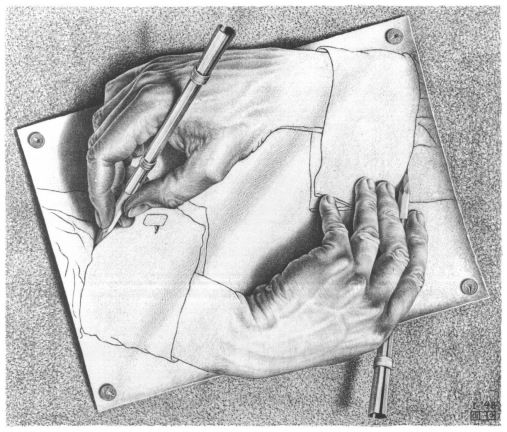
(There will be 2 kickoff meetings on Thursday, April 19th. One at 9am & one at 6pm PST on Architecture Island. The experiment will run from April 19th – May 19th. The following document is posted at the following Wiki: Wikitecture 2.0: Program and Protocol… here’s the pdf)
Like any new burgeoning idea or philosophy, a number of words start springing up to capture its essence with greater accuracy. The growing excitement around Web 2.0 is no different. The following have been sighted in trying to describe this new phenomenon: Mass Collaboration, Social Networking, Wikis, Folksonomies, Open Source, Prosumers, Networked Intelligence, Crowd Sourcing, Crowd Wisdom, Smart Mobs, Peer Production, Lightweight Collaboration, Emergent Intelligence, Social Production, Self-Organized Masses, Collective Genius, Loose Networks of Peers, and Collaborative Infrastructures. But to use Wikipedia’s definition, which is fast approaching the voice of authority, Web 2.0 refers to a ‘perceived second generation of Web-based services that emphasize online collaboration and sharing among users.” My personal favorite portrayal is ‘a shared canvas where every splash of paint contributed by one user provides a richer tapestry for the next user to modify or build on.’
The ideas behind the online collaborative spirit of Web 2.0 have been successfully harnessed in a wide array of disciplines, such as: Wikipedia, Linux, MySpace, InnoCentive, Flickr, Second Life, You Tube, and the Human Genome Project to name a few. With books such as ‘Wikinomics: How Mass Collaboration Changes Everything’ fast approaching the New York Times best seller list, it seems as though peer production could provide alternative ways of working for a growing number of other disciplines as well. The question is: Can a field as subjective as architecture, or design in general, benefit from this collective intelligence paradigm?
To help answer this question, ‘Real Life Architects in Second Life’ (RLASL) will be conducting a ‘Wikitecture’ experiment on Architecture Island in Second Life over the next month to determine just how feasible a collaborative approach in design might be in the architectural profession. Not only will we aspire to create a noteworthy building design in the process, we want to use this experiment to explore and flesh out the specific measures, protocol, and tools necessary to make collaborative, asynchronous design in architecture a reality. I guess it goes without saying that since this is an experiment around open collaboration, we need contributors—we need you. You do not have to have any experience in Architecture or building to participate. We actually believe the more diverse the pool of contributors, the better. Whether you contribute to the design of the building or offer suggestions on how to improve the process of open-design, we welcome and need, any contributions you may have; no matter how big or small. Help us work out if there’s an Architecture of Architectural Design Collaboration?
Since RLASL revolves around using Second Life as a professional and educational tool, we would like the contributors to pretend as though they are designing a real life building and try to address, as this building design evolves, not just design’s ‘delight’, but also its ‘commodity’ and ‘firmness’ as well. Make Vitruvius proud as they say.
When designers are given cart blanche to design anything their imagination can muster, the possibilities are so numerous, finding a direction can sometimes prove difficult. In this vain, we wanted to provide a program for this Wikibuild that would give designers an initial direction, but vague enough, in turn, not to restrict any sense of innovation or creativity.
The Program Catalyst:
The project, located somewhere outside San Francisco, will be conceived of as an artist retreat to host any number of educational and social activities for the ‘RL Architects in SL’ group. Of the few stipulated functions, the building should accommodate an internal courtyard. Since the courtyard will mostly likely be the main gathering area, a large viewing screen, ideally incorporated into the architecture, should be located along one edge of the courtyard. In addition, to play off the burgeoning sustainability movement, a green roof will be located on top of the surrounding building(s). The program, however, in the encircling building can evolve into whatever the community of designers deems appropriate, but an entrance, classrooms, workshops, a library, a kitchen, or offices might be potential candidates and of course, per code, restrooms might be a good idea as well.
Since there are quite a number of students that visit the island, we thought it might be educational if the design of the building itself acted as an exposé of a few basic architectural principles; namely those principles outlined in Francis Ching’s book Architecture: Form, Space, & Order. We ask, as you develop the design to try to incorporate some on the architectural principles outlined in the following table. Do not feel, however, that you have to incorporate every single concept exhaustively; the design would most likely run the risk of becoming a little too chaotic. For those principles that cannot be accommodated within the architecture, we ask that the community designs small simple garden follies within and around the rooftop garden to demonstrate these missing principles.If you do not have access to Ching’s Book, the following PowerPoint lectures, although not exhaustive, cover a majority of the principles outlined above:
| Primary Elements | Form and Shape | Transformation of Form |
|
point elements linear elements planar elements volumetric elements |
visual properties relational properties primary shapes and forms -circle -triangle -square -sphere -cylinder -cone -pyramid -cube |
dimensional transformation subtractive form additive forms centralized form linear form radial form clustered form grid form |
| Manipulation of Form | Horizontal Elements Defining Space | Vertical Elements Defining Space |
|
formal collisions of geometry -circle and square -rotated grid articulation of form -edges and corners -surfaces |
base plane elevated base plane depressed base plane overhead plane |
vertical linear elements single vertical plane L-shaped planes parallel planes U-shaped planes four planes: closure |
| Openings in Space-Defining Elements | Qualities of Architectural Space |
Spatial Relationships |
|
opening within planes openings at corners openings between planes |
proportion scale definition degree of enclosure light view |
space within a space interlocking spaces adjacent spaces spaces linked by a common space |
|
Spatial Organizations |
Circulation |
Ordering Principles |
|
centralized organizations linear organizations radial organizations clustered organizations grid organizations |
circulation elements building approach building entrances configuration of path path/space relationships form of the circulation space |
axis symmetry hierarchy datum rhythm repetition transformation |
If you do not have access to Ching’s Book, the following PowerPoint lectures, although not exhaustive, cover a majority of the principles outlined above:
http://archone.tamu.edu/~ENDS205/LECTURE1.ppt
http://archone.tamu.edu/~ENDS205/LECTURE2.ppt
http://archone.tamu.edu/~ENDS205/LECTURE3.ppt
http://archone.tamu.edu/~ENDS205/LECTURE4.ppt
http://archone.tamu.edu/~ENDS205/LECTURE5.ppt
http://archone.tamu.edu/~ENDS205/LECTURE6.ppt
http://archone.tamu.edu/~ENDS205/LECTURE7.ppt
http://instruct.westvalley.edu/clancy/design32b/lect01.ppt
http://instruct.westvalley.edu/clancy/design32b/lect02.ppt
http://instruct.westvalley.edu/clancy/design32b/lect03.ppt
Mod-Rights:
The 1st experiment, Wikitecture 1.0 was not really a true Wiki in the sense that contributors could not modify or delete the contributions of others. What resulted, although interesting in its own right, was an amalgamation of ‘stuff’ with not no overall coherency or unity.
Image of Wikitecture 1.0
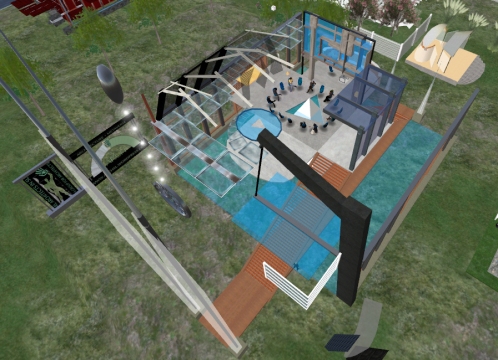
This next experiment however, we want to ask all the contributors to turn on their Prim’s[1] permissions so their fellow contributors can modify and evolve the design over time. Obviously the quick answer, to allow your fellow contributors modification rights, would be to grant them permission by checking the ‘can modify my objects’ box in your friends list. Although this would be ideal for collaborating on this Wikibuild, we run the risk of a rogue ‘griefer’ deleting a fellow member’s creation somewhere else in SL’s world. So until SL allows citizens mod-rights to certain people in certain places, we have to take a few additional precautionary steps.
In order for all the members within RLASL to modify their fellow member’s contributions, all the prims within the Wikibuild must have the following permissions turned on in the‘General’ tab of their ‘Build’ window.
The following image illustrates:
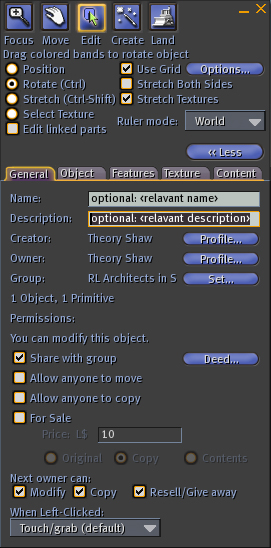
• ‘Group:’ should be set to ‘RL Architects in Second Life’
(A newly created object will take on your ‘Active’ group name. —i.e., if you make ‘RL Architects in Second Life’ your active group it will be the default group with every new prim created.)
• Check on ‘Share with group’
(Do not however click on the ‘Deed…’ button and deed the object to the group. If there are scripts associated with group owned objects there’s a chance they may not work properly, considering most scripts rely upon the object to be owned by a singer owner.)
• Turn on ‘Modify’ and ‘Copy’ under ‘Next owner can:’
• Turn on ‘Resell/Give away’
(In order to allow others to copy the Wikibuild (or past achieves) into their inventory and rerez them somewhere else to work in private, ‘Resell/Give away’ needs to be turned on.)
Unfortunately, and I may have missed a way of doing this, you cannot set these permissions as the default mode and have all new prims take them on initially. —i.e., newly created objects will default back with no permissions. To get around not setting these every time, you can either copy the permissioned object and change it while still preserving the permission settings or when done building for the day, select all your objects and change the permissions at one time. Whatever is easier for you.
Unfortunately, although contributors will be able to copy the objects of their fellow designers, they cannot use the object’s associated texture on a newly created prim—since they do not have the texture in their inventory. If you find yourself in this situation, do one of the following: either copy the prim with the desired texture and change it’s ‘building block type’ into the prim shape you want or just ask the person who made the prim originally and see if they can send you the texture.
Prim Conservation:
To insure that all the stuff in SL uploads and downloads evenly for all users, SL puts a limit on the number of Prims you can have on your property. As a result, all builders in SL are faced with the challenge and art of trying to convey the most, with the least amount of Prims. Employing a wise use of textures can sometimes substitute for the need to physically model the object in SL. For instance, a transparent texture with mullion patterns could be used instead of actually modeling the mullions in world or instead of using 4 prims to outline a typical window, use one box prim with the middle hollowed out. Other areas that might benefit from a judicious use of textures might include: fences, siding, and roofing patterns. As a general rule: Anything that’s small and repeats often is a prime opportunity for a wise use of textures.
In the 3,456 sq. meter area allotted for this Wikibuild, SL allows for a maximum of 790 prims. Yes, this is a very tight number, especially if you’re used to the seemingly infinite number allotted in any other modeling programs. Although I’m sure as bandwidth increases in the future this number will only go up, but for know please be conservative with your prim use.
For those who want to create transparent textures this tutorial is very helpful:
http://www.sluniverse.com/kb/article.aspx?id=10199
An image of the building site:
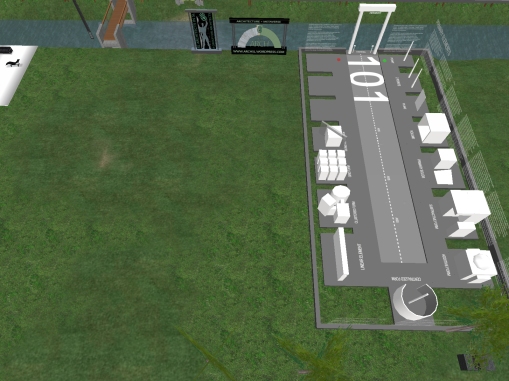
Dimensions of the land plat.
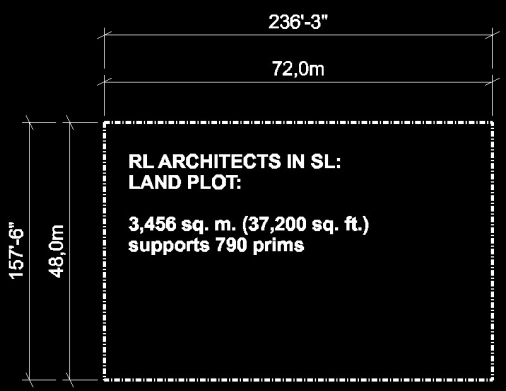
Building with an Off-line Modeller:
Many have asked the question whether it’s possible to import third party models such as Maya, Blender, and Sketchup into Second Life. The answer is yes, but the elaborate conversion process you have to go through, with the few beta programs out there, is sometimes more work than its worth. The following is a list of the current conversion programs under development, but unless you have a warm affinity for the programming code you’ll have to cut and paste from one program to another, you might be better off learning to model in SL proficiently.
From Maya:
From Blender:
From Sketchup:
From Max:
If you do, however, use an offline modeler, make sure you approach the building process as though you are building in Second Life, —i.e., avoid curvaceous nurbs and surfaces; stick with primitives.
A Tool to Rank and Build Consensus around the Design:
So by what means do we, as a community of designers, determine how the community feels about the contributions of its members and as a result what design direction would make the most contextual sense? Ultimately in later phases of the Wikibuild experiment we would like to write a LSL script of some sort that would allow contributors to quickly rank and comment on what aspects of the project are working or not, but in the meantime let’s develop a rudimentary ranking system with the technology that’s currently available—a mashup of sorts. RLASL has set up a Flickr account called ‘Studio Wikitecture’, where contributors can upload snapshots of certain locations of the Wikibuild and be able to comment on what aspects of the project, in their eyes, either work positively or negatively. In addition to posting comments under the images, contributors can ‘post a topic thread’ to argue more specific points as well. Along with acting as a forum for comments, individual designers can elaborate on the logic behind their designs as well—in an effort ultimately to bring their fellow designers around to their way of thinking. And finally, to help the community quickly access what aspects of the design are either working or not, RLASL will periodically divvy up the individual posts into the following Flickr sets:
(=)Debated Topics(=)
(-)Negative Comments Overall(-)
(+)Positive Comments Overall(+)
If you do not want to give any textual feedback or even in addition to, a good way for us to tally quickly what design direction the group favors, would be to use the ‘Add to Faves’ button on the upper right of any Flickr image (see the following image). Along with positive comments, favoring images would help RLASL determine with more confidence which images should be moved to the (+)Positive Comments Overall(+) Flickr set.
Using the ‘Add to Faves’ button
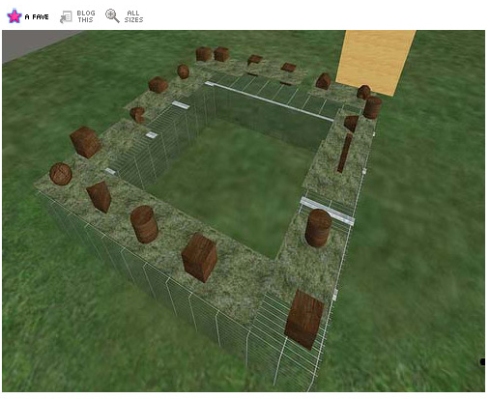
Uploading the snapshots to the ‘Studio Wikitecture’ Flickr account:
Option #1: Sending Snapshot via email:
(because Flickr does not accept BMP files, you cannot send the snapshots via the ‘send a postcard’ function in SL. You have to download them to your hard drive and convert to a JPG before sending them off to Flickr.)
- Take a snapshot(s) of whatever portion of the Wikibuild you’d like to comment on and ‘save [the] snapshot to hard drive’
- Convert the snapshot file from a BMP to JPG format. This can be done with a number of programs; such as Adobe Photoshop or Microsoft Paint. Use XnView if you’d like to batch covert a number of BMP files all at one.
- Attach the JPG file(s) to an email with the following address: next00beyond@photos.flickr.com. (This is the email address Flickr has assigned to the ‘Studio Wikitecture’ account.)
- Use the ‘subject’ and ‘body’ of the email to write a little blurb explaining the rationality behind your design—as exhaustive or as brief as you want.
- send away.
Option #2: Sending Snapshot to Flickr via blogbud.com:
(This method might be a little more cumbersome on the front end, but once setup, it avoids converting from BMP to JPG format. In addition, since your posts will not only go to the Flickr account, but the main Bloghud feed as well, Wikitecture 2.0 might garner a little more interest from the outside community—potentially bringing in additional contributors. One drawback, however, is the images come in rather small (258×345) in Flickr.
- Go to http://bloghud.com/ and create a Pro Version account, which will cost you around US$ 3.70 (L$900). (Unfortunately you cannot send images to Flickr with their free account.)
- They will ultimately send you to the following slurl link to pick up a HUD (Heads-Up Display) called blogHUDPRO: http://slurl.com/secondlife/Nooribeom/181/186/23
- After you follow their not so friendly setup instructions and have a fully operable account, go to ‘manage my bloghud.com profile’ on their website and enter in the ‘Studio Wikitecture’ Flickr address: next00beyond@photos.flickr.com. (Unfortunately, Bloghud does not remember multiple Flickr addresses so if you already use Bloghud to send photos to another Flickr account, you’d probably be better off using the first alternative and sending snapshots via your email.)
- After all is said and done you can finally send snapshots via the ‘send a postcard’ function in SL to the Flickr account using Bloghud’s email address: pix@bloghud.com. Got that?… me neither.
As you can tell, this is not the most ideal method for tallying the thoughts and opinions of the group, but it’s a start. As hinted at before, please use this Wiki to offer any suggestions or ideas you may have to improve this process, such as other mashups or possibly even a ranking script.
Archiving:
As a contributor, we ask that at the end of your work day, that you save a copy of the entire Wikibuild (with your modifications, of course) to the Archive Kiosk that’s near the foot bridge to ‘Crescendo Design’s Eco-friendly Neighborhood’. In this way, if the community, via a demonstrable Flickr Forum consensus, decides to ‘roll-back’ the design or if individual contributors would like to elaborate on an old idea, they have onsite access to past iterations of the design.
Image of ‘Archive Kiosk’
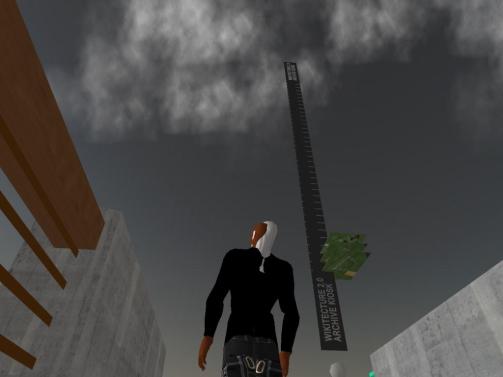
If you’re not familiar with how to save prims inside other prims, the following steps should help. Here’s the short version: Take a copy of an existing ‘archive plate’ and rerez it anew onto the next rung of the ‘archive kiosk’. Replace the previous contributor’s archive with your newly updated Wikibuild design. Replace the texture image attached to the ‘archive plate’ with an updated image illustrating your work. If so inclined, please leave a little blurb explaining the rationality behind your modifications within the attached notecard called: -Notes on the Design <don’t rename>.
Here’s a longer version of how to archive at the kiosk:
1. SELECT all the prims and objects that make up the Wikibuild
2. Right click on any of the prims to display the pie menu… click on ‘More>’ and then click on ‘Take Copy’. A copy of all these prims and objects will be sent to your inventory under the ‘objects’ folder and simply named: ‘object’.
3. Right click on the ‘object’ to rename. Pick any naming convention that you like; including you name and date might help.
4. ‘Upload a snapshot(s)’ of either the entire Wikibuild or the areas that you modified. It will be sent to your ‘Photo Album’ folder in your inventory.
5. Go over to the ‘Archive Kiosk’ and right click on the most recently dated ‘Archive Plate’ to display the pie menu and click on ‘More>Take Copy’. A copy of the ‘Archive Plate’ will be sent to your inventory.
6. Drag the ‘Archive Plate’ from your inventory into the world and reposition on the next rung of the ‘Archive Kiosk’. (note: The script that gives the UTC date and time only works when the ‘Archive Plate’ is rezzed in this manner.)
7. Right click on this newly rezzed ‘Archive Plate’ and go to ‘Edit’
8. Go to the ‘Content’ tab in the ‘Build Window’ and delete the last contributor’s Wikibuild Archive, do not, however, delete the following script: ‘Date Archive Prim was made’
9. Drag the Wikibuild Archive that you made and renamed in steps 2&3 into the ‘Content’ tab.
10. Optional Step: Open the Notecard in the ‘Content’ tab called: -Notes on the Design <don’t rename>. Within it, please add on to the running dialog with a little blurb explaining the rationality behind your design. See following example. In addition, send this little blurb with some pertinent snapshots of the Wikibuild to the Flickr sight dedicated to this Wikitecture experiment—as mentioned in the previous section. Upload blurb and images via your email with this email address: next00beyond@photos.flickr.com
**(Because Flickr does not accept BMP files, you cannot send the snapshots via the ‘send a postcard’ function in SL. You have to download them to your hard drive and convert to a JPG before sending them off to Flickr—as mentioned in the previous section.)**
An example of the running dialog within the Archiving Notecard:
–Theory Shaw: (4/11/2007 – 2:52 AM)
example text:
but i really think…
i agree that was a weakness…
i like Indie’s…. so i…
–Indie Nyle: (4/11/2007 – 2:48 AM)
example text:
well i thought this…
i modified your…
i deleted… because
why theory… why?
–Theory Shaw: (4/11/2007 – 2:42 AM)
example text:
I was trying to…
I was playing off…
I did this because…
I think…
wouldn’t it be nice…
11. Go to the ‘Texture’ tab and replace the previous contributor’s snapshot with the one you made in Step 4.
12. Done.
Building in a location off-site:
If you prefer to take a copy of the Wikibuild somewhere else, such as a Sandbox, to work on it in private, please, before you update the ‘live’ build, make sure someone hasn’t modified the live build during your absence. If this be the case, please try your best to incorporate the other contributor’s modifications into your own. If by some remote chance, the two (or more) designs are too different to merge together nicely, please document your design via images and comments in the dedicated Flickr account and archive your design at the ‘Archive Kiosk’. In order to get the community to weigh a judgment as quickly as possible between the two (or more) designs, ‘Create [a] New Notice’ within the RLASL’s ‘group information’ window and explain that a conflict has arose and you’d like the community’s assessment as soon a possible. As you can see, from the amount of jockeying this might cause, it might be safer to stay onsite to make your design modifications.
Payouts:
What if this process of collaborative design does ultimately lead to a viable way to design architecture? How will you get paid, if the criteria for establishing the weight of one’s contribution is somewhat subjective? Although finding the criteria for logically dividing the work is almost impossible, especially in creative fields, we believe if you allow the community to vote on each other’s perceived contribution, however subjective their individual assessment might be, when averaged out, a fair and balanced assessment will most likely result. Although a small gesture, RLASL would like to put forth L$80,000 Linden Dollars (US$300) as a payout for design services rendered by the group; the distribution of which will be determined by group vote. The final vote will occur at the end of the month long design charrette. Since it would appear that the community will consult the ‘Studio Wikitecture’ Flickr Forum to help inform their votes toward the payout percentages, it would seem advantageous to document as much of your work within this forum as possible.
(I’m sure this is relatively simple as programming goes, but if anyone would like to offer up a website that would automate this task of taking votes and tallying the results, please let me know. If not, I will most likely just request the vote through email and I’ll tally the results manually. Ideally I would like to avoid any manual tally to prevent any perceived conflict of interest. )
Forking the Design:
What if, as the design evolves, factions form that cannot reach a consensus in the project’s continued design direction? In that case, not unlike open source software, the project can fork off into two separate divergent designs. Obviously we would like to avoid this since it would take a substantial amount of momentum out of the project, but on the other hand we do not want to squelch what could very well be a viable improvement of the design as well. Unfortunately, due to available land restrictions, Architecture Island can only host one ‘live’ built at a time. If the project does indeed fork, someone will have to offer land to host the additional project. The determination of what project goes where, will be left up to group vote. To give further incentive to stick out the evolution of one design, the payout can only be divvied up amongst the contributors of the one project that wins the community’s vote.
Adjusting the Scale of Your Contribution:
Although this will be hard to regulate, we ask that the magnitude and scale of modifications to the design become less and less as we approach the end of this charrette. —i.e., if we are three weeks into the design, reconceptualizing the schematic layout of the building might be counterproductive. The community will mostly likely self-regulate this from happening however.
Open Questions:
The following are open questions that this experiment will look to answer. And as mentioned initially, as this experiment evolves, if you have any other questions you’d like to post, or modifications to the program in general, that you think might help inform this and further Wikitecture experiments, please do so at the following Wiki pages.
Wiki for this Program and Protocol:
Wiki for Refining the Tools for Building Design Consensus:
Wiki for the Questions this Experiment Poses:
Open Questions:
– Will the aggregate of a diverse pool of contributors, with their varying view points on design, produce a final project of any aesthetic worth or will it just be an amalgamation of stuff with no overall coherency?
– Since computer code or encyclopedic entries can be modularized into bite-size pieces it’s easier for individuals to make small contributions, that when aggregated, are more than the sum of their parts. Since the act of designing cannot easily be divided up into bite-size tasks, will an open collaborative approach to architecture even work?
– What if this process of collaborative design does ultimately lead to a viable way to design architecture? How will you get paid, if the criteria for establishing the weight of your contribution is somewhat subjective?
– How could using the Flickr account to log the history of the communities viewpoints be improved upon? What other types of ‘mashups’ would better convey the community’s design intentions?
– This project is strictly community driven—i.e., the community determines the design will evolve. When, however, you have a client driven project, where the client is calling out the design direction, will the community be less apted to participate? Or could they possibility be more willing to participate knowing they are not at the whim of a ever changing landscape of design criteria?
– Will architects, who historically have been individualistic by nature, even want to participate in a process where their contributions could potentially be watered down?
– Will this be quicker than the conventional way to develop a design?
– Would RW clients be open to a community of designers designing their projects?
– With so many cooks in the kitchen, so to speak, will the design evolve into a lowest common denominator of conservative mediocrity?
– If this experiment results a project worthy design, can you continue utilizing a Wiki approach in later phases of an architectural project; such as DD (Design Development) and CD (Construction Document) phase?
One Last Note:
I sincerely hope that this approach to designing architecture creates a project more than the sum of its parts. If so, could small neighborhoods, or even municipalities use this approach to bring their residences further into the design process—creating an environment that, as the great urbanist Jane Jacobs coined, “is multidimensionally diverse— one that does not just cater to a single industry or a single demographic group but that is full of stimulation and creative interplay.”
And finally, if this experiment does prove itself on some level, we would like to extend an invitation to any real world clients who would like to offer up their next real world project as the centerpiece in the 3rd Wikitecture experiment? The design, of which, will be more client driven, verses the community driven approach this experiment illustrates. If so, please contact either Keystone Bouchard or Myself (Theory Shaw) via an IM in Second Life. We would be excited to have a real world setting to demonstrate the potentials of a Wikitecture approach in architecture.
We would like to thank the community in advance for their contributions and we hope, if at the very least, this experiment reveals in some small fashion the potential uses metaverses, such as Second Life, might have for not just architects, but any for anyone affiliated with the building industry.
[1] “Prim”= primitive. A primitive is a basic shape: cube, sphere, torus, and so on. Everything you can build in Second Life is made up of primitives.


